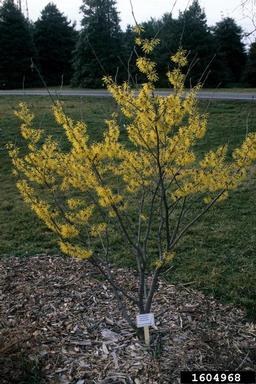Posted: January 18, 2022
See how a snowy landscape can be more enhanced with a pop of color from a witch hazel tree.

Photo by bugwood.org, J. Ruter
Walking in the woods on a cold winter day and seeing a small tree covered with yellow flowers is a joyous sight. The native witch hazel, Hamamelis virginiana, often called a shrub because of its many branches, flowers when temperatures dip below 45 degrees. The flowers, that resemble forsythia, can last for two months or more. They curl up in freezing weather and unfurl when temperatures rise. Their citrus fragrance is very pronounced when stems are cut and placed in a warm room.
Historically, witch hazel is well known for its medicinal qualities. Native Americans used its bark and leaves to reduce inflammation and fever. Today it is used in cosmetics and as first aid for cuts and skin irritations.
Witch Hazels are well suited to the home garden as a specimen or hedge. They do well even in poorly drained soil, in shade, partial shade, or full sun and grow to 6-12 feet and spread to 10-15 feet. Cultivars are available with yellow, red, or white flowers. Birds enjoy the small black seeds that are ejected from the fruits in autumn, the year after the fruits mature. The fruits can eject their seeds for up to 30 feet from the tree. The tree is a host to two moths in Pennsylvania, The Witch Hazel Dagger Moth and the Witch Hazel Caloptilia.

